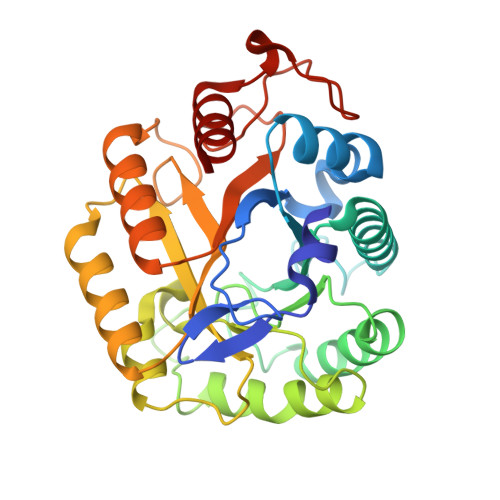Structural, Thermodynamic, and Kinetic Analyses of Tetrahydrooxazine-Derived Inhibitors Bound to {Beta}-Glucosidases
Gloster, T.M., Macdonald, J.M., Tarling, C.A., Stick, R.V., Withers, S.W., Davies, G.J.(2004) J Biol Chem 279: 49236
- PubMed: 15356002
- DOI: https://doi.org/10.1074/jbc.M407195200
- Primary Citation of Related Structures:
1W3J, 1W3K, 1W3L - PubMed Abstract:
The understanding of transition state mimicry in glycoside hydrolysis is increasingly important both in the quest for novel specific therapeutic agents and for the deduction of enzyme function and mechanism. To aid comprehension, inhibitors can be characterized through kinetic, thermodynamic, and structural dissection to build an "inhibition profile." Here we dissect the binding of a tetrahydrooxazine inhibitor and its derivatives, which display Ki values around 500 nm. X-ray structures with both a beta-glucosidase, at 2 A resolution, and an endoglucanase at atomic (approximately 1 A) resolution reveal similar interactions between the tetrahydrooxazine inhibitor and both enzymes. Kinetic analyses reveal the pH dependence of kcat/Km and 1/Ki with both enzyme systems, and isothermal titration calorimetry unveils the enthalpic and entropic contributions to beta-glucosidase inhibition. The pH dependence of enzyme activity mirrored that of 1/Ki in both enzymes, unlike the cases of isofagomine and 1-deoxynojirimycin that have been characterized previously. Calorimetric dissection reveals a large favorable enthalpy that is partially offset by an unfavorable entropy upon binding. In terms of the similar profile for the pH dependence of 1/Ki and the pH dependence of kcat/Km, the significant enthalpy of binding when compared with other glycosidase inhibitors, and the tight binding at the optimal pH of the enzymes tested, tetrahydrooxazine and its derivatives are a significantly better class of glycosidase inhibitor than previously assumed.
Organizational Affiliation:
Structural Biology Laboratory, Department of Chemistry, University of York, Heslington, York, YO10 5YW, United Kingdom.



















